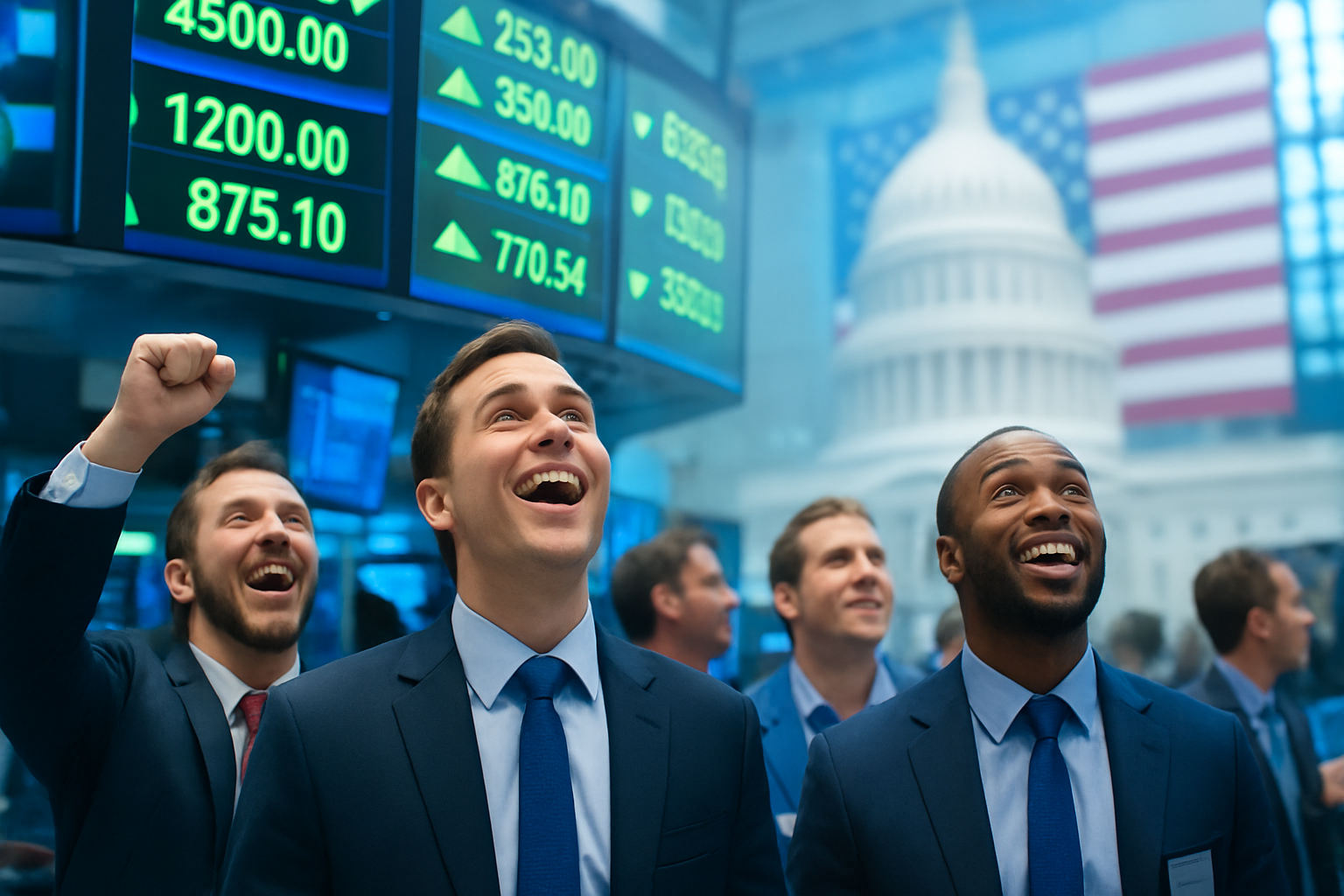
Global equity markets have surged in early November 2025, fueled by renewed optimism that the United States government's historic shutdown, which commenced on October 1, 2025, may finally be nearing its conclusion. The protracted impasse, now the longest in the nation's history, has cast a shadow of uncertainty over the economy, but recent legislative developments have ignited a significant "risk-on" rally across major indices. Investors are now keenly watching for a definitive resolution, hoping to restore stability and clarity to the financial landscape.
The rally reflects a collective sigh of relief from market participants who have grown increasingly concerned about the economic fallout of the shutdown. With hundreds of thousands of federal employees furloughed or working without pay, and critical economic data releases delayed, the financial markets have been operating under a cloud of speculative anxiety. The prospect of an end to this deadlock is being met with enthusiasm, signaling a potential return to fundamental-driven trading and a reduction in political risk premiums.
Unpacking the Prolonged Standoff and Market's Elation
The current US government shutdown, initiated at the start of the 2026 fiscal year on October 1, 2025, has become a defining feature of the financial news cycle. This unprecedented closure, now surpassing 40 days, stems from a deep-seated disagreement between the Republican-led House and the Democratic-controlled Senate over appropriations legislation. A primary point of contention revolves around the Democratic party's push to extend Affordable Care Act (ACA) subsidies, which are slated to expire at the close of 2025 – a provision largely opposed in the Republican bill. Repeated attempts to pass stopgap funding measures have failed, leading to the furlough of approximately 900,000 federal employees and many more continuing their duties without immediate compensation.
Economically, the shutdown has exerted a tangible drag, with estimates suggesting a weekly subtraction of about 0.1% from annualized GDP growth due to curtailed government activity and disrupted public services. Beyond the direct economic hit, the absence of crucial economic data, such as inflation reports and employment figures, has created an information vacuum. This lack of transparency could complicate the Federal Reserve's ability to make informed decisions regarding interest rates, potentially impacting market pricing for future rate adjustments.
Despite the underlying economic concerns, the stock market has demonstrated a remarkable resilience, particularly in response to perceived progress towards a resolution. On November 9, 2025, a pivotal moment occurred when the Senate successfully cleared a crucial procedural vote on a funding bill. This breakthrough was immediately interpreted by investors as a significant reduction in the probability of a prolonged closure, triggering a sharp and widespread rally. The S&P 500 (INDEXSP:.INX) gained 0.6% during the shutdown period leading up to this point, slightly above its historical average return during similar impasses. Nasdaq 100 (INDEXNASDAQ: .NDX) futures also saw substantial gains, reflecting a renewed appetite for growth-oriented assets. This "risk-on" sentiment permeated global markets, lifting commodities such like oil and metals, and even boosting cryptocurrencies like Bitcoin. European and Asian markets followed suit, registering strong performances as traders rotated into technology and cyclical sectors, anticipating a clearer economic outlook once the shutdown concludes.
Corporate Fortunes Tied to Government Operations
The resolution of a government shutdown carries significant implications for a diverse array of public companies, with some poised to benefit substantially while others may face a period of recovery from operational disruptions. Companies heavily reliant on government contracts, such as defense contractors like Lockheed Martin (NYSE: LMT) and Northrop Grumman (NYSE: NOC), or IT service providers to federal agencies like Leidos (NYSE: LDOS) and Booz Allen Hamilton (NYSE: BAH), often experience project delays and payment interruptions during a shutdown. The end of the impasse would likely trigger a resumption of these contracts, leading to accelerated revenue recognition and improved cash flow.
Similarly, industries that require federal permits, inspections, or regulatory approvals, such as energy companies, pharmaceutical firms, and certain manufacturing sectors, often face bottlenecks during a shutdown. For instance, new drug approvals by the Food and Drug Administration (FDA) or environmental impact assessments by the Environmental Protection Agency (EPA) can be delayed. The reopening of government agencies would streamline these processes, potentially unblocking revenue streams and accelerating product launches for companies like Pfizer (NYSE: PFE) or ExxonMobil (NYSE: XOM).
Conversely, some sectors might see a slight shift in investor focus as the "safe haven" appeal diminishes. Utilities and consumer staples, often considered defensive plays during periods of economic uncertainty, might experience a temporary rotation of capital into more cyclical or growth-oriented sectors. Furthermore, companies that rely on discretionary consumer spending could see a boost if furloughed federal workers receive back pay and resume normal spending patterns. Retailers like Walmart (NYSE: WMT) or Amazon (NASDAQ: AMZN), and hospitality companies, could see increased activity as consumer confidence improves and delayed purchases are made. The overall sentiment shift from uncertainty to stability typically benefits the broader market, allowing companies to operate without the added layer of political risk.
Broader Economic Canvas and Historical Echoes
The resolution of the government shutdown, particularly one of this historical magnitude, fits into a broader narrative of political stability influencing economic performance. Prolonged political impasses, even if their direct economic impact is statistically modest in the long run, erode business and consumer confidence. This erosion can lead to delayed investment decisions, cautious hiring, and reduced discretionary spending, ultimately stifling economic growth. The current event underscores the interconnectedness of political governance and market sentiment, highlighting how legislative functionality is a prerequisite for a predictable and robust economic environment.
The ripple effects of such a shutdown extend beyond directly contracted entities. Small businesses that serve federal employees or rely on federal programs can face severe liquidity crises, potentially leading to layoffs or even closures. Partners of large government contractors might also experience disruptions in their supply chains or payment schedules. Internationally, a prolonged US government shutdown can raise questions about the reliability of the US as a global economic actor, potentially impacting trade negotiations, foreign investment, and the stability of the dollar. Regulatory bodies, once fully operational, will face a backlog of work, which could still lead to delays in various approvals and oversight functions in the short term.
Historically, US government shutdowns have typically had a modest and often transient impact on financial markets. Since 1976, over 20 shutdowns have occurred, none directly triggering a recession or a bear market. The S&P 500 has posted positive returns during half of these closures, and in most cases, was higher three and six months later. For instance, the 35-day shutdown from December 2018 to January 2019, previously the longest, coincided with a strong equity rally in the subsequent year. This historical precedent suggests that markets tend to "look through the noise" of political gridlock, ultimately refocusing on fundamental drivers such as corporate earnings, economic growth, and monetary policy. The current rally, therefore, aligns with this pattern, as investors anticipate a return to these fundamentals once the political uncertainty dissipates.
Navigating the Path Ahead: Opportunities and Challenges
The imminent end to the US government shutdown heralds both short-term relief and long-term considerations for the financial markets and corporate America. In the immediate aftermath, a wave of pent-up demand and delayed government activity is expected to release. This could translate into a quick boost for sectors that were directly impacted, such as government contractors and industries awaiting regulatory approvals. The return of federal workers to their posts, coupled with potential back pay, is also likely to inject liquidity into local economies, benefiting consumer-facing businesses. Short-term market opportunities may emerge as investors rotate further into cyclical stocks and growth equities, anticipating a clearer economic picture and potentially more aggressive Federal Reserve action based on newly released economic data.
Looking further ahead, the experience of this record-breaking shutdown could prompt strategic pivots within companies and government agencies. Businesses heavily reliant on federal contracts might explore diversifying their client base or building stronger financial reserves to weather future political impasses. Government agencies, in turn, might assess their essential functions and contingency plans to minimize disruption during future funding gaps. The event could also spur discussions on legislative reforms aimed at preventing such prolonged shutdowns, although the political will for such changes remains to be seen.
Potential challenges include the lingering effects of the information vacuum on economic policy decisions and the time it will take for all furloughed services to fully resume. While the market has rallied on hopes of a resolution, the specifics of the funding bill and any attached riders could still introduce new uncertainties. Investors will be watching for the final legislative text, the immediate economic data releases, and any forward guidance from the Federal Reserve regarding interest rates. Potential scenarios range from a swift, uneventful return to normalcy, fostering sustained market growth, to a more staggered recovery if the political divisions that led to the shutdown persist and threaten future legislative action.
A Return to Fundamentals: The Market's Enduring Resilience
The recent stock market rally, driven by the anticipated end of the historic US government shutdown, underscores a fundamental truth about financial markets: while political uncertainty can introduce volatility, the market's long-term trajectory is predominantly shaped by economic fundamentals, corporate earnings, and monetary policy. The swift positive reaction to the Senate's procedural vote on a funding bill highlights investors' eagerness to move past political gridlock and refocus on the underlying health of the economy. This event serves as a powerful reminder that periods of political tension, while disruptive, often prove to be temporary detours rather than permanent roadblocks for equity performance.
Moving forward, investors should closely monitor the actual passage of the funding legislation and the subsequent resumption of all government operations. Key takeaways from this episode include the market's inherent ability to "price in" potential resolutions and its historical tendency to rebound strongly after political impasses. The assessment of the market moving forward suggests a likely shift from a "wait-and-see" approach to one driven by renewed confidence, potentially fostering further growth in sectors that thrive on economic stability and robust consumer and business activity.
Final thoughts on the significance and lasting impact revolve around the potential for increased scrutiny on legislative processes and perhaps a renewed emphasis on bipartisan cooperation to avoid future shutdowns of this magnitude. What investors should watch for in the coming months includes the speed at which delayed economic data is released and its implications for Federal Reserve policy, the performance of government-dependent sectors as contracts resume, and any legislative efforts to prevent similar future events. The market, having weathered this storm, appears poised to re-engage with its core drivers, but the memory of this historic shutdown will undoubtedly inform future risk assessments.
This content is intended for informational purposes only and is not financial advice






